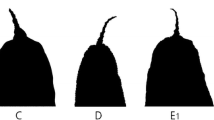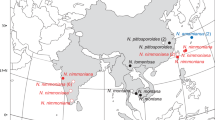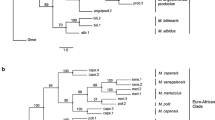Abstract
Opuntia abjecta and O. militaris have been placed in synonymy under the Caribbean species O. triacantha for the past 30 years. Recent molecular phylogenetic evidence has shown, however, that O. abjecta and O. triacantha are actually in two very different clades suggesting that the Floridian endemic O. abjecta should be recognized as a distinct species. Here, we summarize major morphological differences between O. abjecta and O. triacantha. We also include new sequence data from the rare Cuban taxon, O. militaris, in a molecular phylogenetic analysis to determine its relationship to O. triacantha and O. abjecta. We discuss the putative hybrid taxa O. cubensis and O. ochrocentra, which currently are treated as synonyms. We also show through analysis of morphological and molecular characters that these two taxa were derived from two independent origins from divergent maternal progenitors, confirming that O. ochrocentra should not be treated as synonymous with O. cubensis. A key is provided for identifying these taxonomically confusing taxa and their close relatives. This study emphasizes the distinctions among O. abjecta, O. militaris, and O. triacantha and illustrates that extreme caution must be employed when using herbarium specimens for identifying species of Opuntia. It also indicates that broad phytogeographic assumptions regarding species’ relationships in Opuntia may sometimes be misleading. Hybridization and polyploidy are common in Opuntia and have played a role in the formation of new species in this group as well. A neotype is here designated for O. triacantha.




Similar content being viewed by others
Literature Cited
Acevedo-Rodriguez, P. 1996. Flora of St. John: U.S. Virgin Islands. New York Botanical Garden Press, Bronx.
Anderson , E. F. 2001. The cactus family. Timber Press, Portland.
B enson , L. 1982. The cacti of the United States and Canada. Stanford University Press, Stanford.
Berazaín, R., F. A. Berazaín, J. C. Lazcano & L. R. González. 2005. Lista roja de la flora vascular Cubana. Gijón 4: 1–86.
Britton, N. L. & J. N. Rose. 1912. Undescribed species of Cuban cacti. Torreya 12: 13–16.
——— & ———. 1920. The Cactaceae Vol. 1. Carnegie Institute of Washington, Washington, DC.
——— & ———. 1923. The Cactaceae Vol. 4. Carnegie Institute of Washington, Washington, DC.
Coile, N. C. & M. A. Garland. 2003. Florida’s endangered and threatened plants. Florida Department of Agriculture and Consumer Services, Gainesville, FL.
Corriveau, J. L. & A. N. Coleman. 1988. Rapid screening method to detect potential biparental inheritance for over 200 angiosperm species. American Journal of Botany 75: 1443–1458.
Doyle, J. D. 1990. Systematics of the Opuntia humifusa complex. Ph.D. dissertation. University of North Carolina.
Edgar, R. C. 2004. MUSCLE: Multiple sequence alignment with high accuracy and throughput. Nucleic Acids Research 32: 1792–1797.
Hunt, D. H., N. P. Taylor & G. Charles. 2006. The New Cactus Lexicon. DH books, Milbourne Port.
Leuenberger, B. E. 2004. The Cactaceae of the Willdenow herbarium, and of Willdenow (1813). Willdenowia 34: 309–322.
Majure, L. C., W. S. Judd, P. S. Soltis & D. E. Soltis. 2012a. Cytogeography of the Humifusa clade of Opuntia s.s. (Cactaceae, Opuntioideae, Opuntieae): Correlations with Pleistocene refugia and morphological traits in a polyploid complex. Comparative Cytogenetics 6: 53–77.
———, R. Puente, M. P. Griffith, W. S. Judd, P. S. Soltis & D. E. Soltis. 2012b. Phylogeny of Opuntia s.s. (Cactaceae): Reticulate evolution, geographic origins, and clade delineation. American Journal of Botany 99: 847–864.
———, ——— & D. J. Pinkava. 2012c. Miscellaneous chromosome numbers in Opuntieae DC. (Cactaceae) with a compilation of counts for the group. Haseltonia 18: 67–78.
NYBG. 1999. Archives and manuscript collections, records of the herbarium (RG 4), John Kunkel Small records (1892-1938), 18.3 linear feet; (28 boxes), http://sciweb.nybg.org/science2/libr/finding_guide/small.asp.
Pinkava, D. J. 2003. Opuntia. Pp. 123-148 in: Flora of North America Editorial Committee (eds.), 1993+. Flora of North American North of Mexico. 12+ vols., New York and Oxford.
Rambaut, A. 2007. Se-Al v. 2.0. Website: http://tree.bio.ed.ac.uk/software/seal/.
Reyes-Agüero, J. A., F. Carlín-Castelán, J. R. Aguirre & H. M. Hernández. 2007. Preparation of Opuntia herbarium specimens. Haseltonia 13: 76–82.
Small, J. K. 1903. Flora of the southeastern United States. Privately Printed, New York, NY.
———. 1913. Flora of the southeastern United States. Privately Printed, New York, NY.
———. 1919. The prickly pears of Florida. Journal of the New York Botanical Garden 20: 21–39.
———. 1933. Manual of the southeastern Flora. Privately Printed, New York, NY.
Spencer, J. L. 1955. A cytological study of the Cactaceae of Puerto Rico. Botanical Gazette 117: 33–37.
Stafleu F. A. & R. S. Cowan. 1988. Taxonomic literature: a selective guide to botanical publications and collections with dates, commentaries and types. 2nd Ed.,Vol. 7. W-Z. Regnum Vegetabile 116., Utrecht, The Netherlands.
Stamatakis, A. 2006. RAxML-VI-HPC: Maximum Likelihood-based phylogenetic analyses with thousands of taxa and mixed models. Bioinformatics 22: 2688-2690.
Ward, D. B. 2009. Keys to the flora of Florida: 23, Opuntia (Cactaceae). Phytologia 91: 383–393.
White, T. J., T. Bruns, S. Lee & J. Taylor. 1990. Amplification and direct sequencing of fungal ribosomal RNA genes for phylogenetics. Pp. 315-322. In: Innis, M.A., Gelfand, D.H., Sninsky, J.J. & T. J. White (eds.), PCR protocols: a guide to methods and applications. Academic Press, San Diego, CA.
Willdenow, C. L. 1814. Cactus triacanthos p. 34. In: von Schlechtendal, F.K. (ed.), Enumeratio Plantarum: Horti Regii Berolinensis: continens descriptiones omnium vegetabilium in horto dicto cultorum supplementum/Carl Ludwig von Willdenow. Berlin.
Wunderlin, R. P. & B. F. Hansen. 2003. Guide to the vascular plants of Florida. Second edition, University Press of Florida, Gainesville, FL.
——— & ———. 2011. Guide to the vascular plants of Florida. Third edition, University Press of Florida, Gainesville, FL.
Acknowledgments
We thank the United States National Herbarium (US), University of Michigan (MICH) herbarium, and The New York Botanical Garden’s Steere Herbarium (NY) for specimen loans; F. Axelrod and T. Majure for help with fieldwork in Puerto Rico; I. Marino and M. Pajuelo for help with fieldwork in the Florida Keys; the Boy Scouts of America and the Key Deer National Wildlife Refuge for providing access to populations of O. abjecta and O. ochrocentra; the Gemini Botanical Garden (G. Gann) for material of O. cubensis s.str.; Montgomery Botanical Center (M.P. Griffith) for material of O. repens from Mona Island; and Desert Botanical Garden (R. Puente) for specimens used in our phylogenetic analyses and for information regarding specimens grown at DBG. The University of Florida Herbarium (FLAS) provided repository space for specimens, and we thank K. Perkins for help with specimen processing. We also thank O. Sida (PR), S. Marner (OXF), S. Lajos, Z. Barina (BP), and H. Väre (H) for information regarding collections of Opuntia and A.M. Powell (SRSU) and A. Salywon (DBG) for helpful comments on an earlier version of the manuscript. Financial support for this work was provided by the Cactus and Succulent Society of America, the American Society of Plant Taxonomists, the Botanical Society of America, the Florida Division of Forestry, and the National Science Foundation (DEB-1011270).
Author information
Authors and Affiliations
Corresponding author
Appendices
Appendix 1. Specimens examined
Opuntia abjecta Small. UNITED STATES. Florida: Monroe Co., Big Pine Key, 12 May 1919, Barrtsch s.n. (US), 4 May 1951, Killip 41332 (US), 10 Jan 1952, Killip 41708 (US), 6 Mar 2010, Majure 3908 (FLAS), 22 Feb 1935, Miller, Jr. 1710 (US), 12 April 1921, Small s.n. (NY), 17 May 1922, Small s.n. (NY, US); Long Key, 23 April 1966, Byrd s.n. (FLAS); Crawl Key, July 2008, Sauby s.n. (FLAS). Opuntia cubensis Britton & Rose. CUBA. Guantánamo: Guantánamo Bay, Oriente, dry sand, valley near coast, 17–30 March 1909, Britton 2064 ( NY); cultivated at Gemini Botanical Gardens, s.d., Areces-Mallea s.n. (FLAS). Opuntia militaris Britton & Rose. CUBA. Guantánamo: Guantánamo Bay, Oriente, coastal hills, 17–30 March 1909, Britton 1957 (NY), 4 Sept 1950, Jervis 246 (MICH), 7 Jan 1951, Jervis 1033 (MICH). Opuntia ochrocentra Small. UNITED STATES. Florida: Monroe Co., Big Pine Key, 12–18 Feb 1935, Killip 31423, (US), 2 Mar 1936, Killip 31712 (US), 19 Mar 1952, Killip 42026 (US), 6 Mar 2010, Majure 3907 (FLAS), 11 Dec 1921, Small s.n. (NY), 17 May 1922, Small s.n. (US); Big Munson Island, 8 Mar 2010, Majure 3968 (FLAS), 8 Mar 2010, Majure 3969. Opuntia repens Bello. UNITED STATES. Puerto Rico: Punta Melones, 26 Feb 1915, Britton s.n. (NY); Mona Island, Griffith 369, 22 Jan 2012 (FTG); Lajas, ca. 5 km NW of La Parguera, off of Hwy. 116, 15 June 2009, Majure 3838 (FLAS); Cabo Rojo, Refugio de vida Silvestre, Salinas de Cabo Rojo, 15 June 2009, Majure 3839 (FLAS). US Virgin Islands: St. Thomas, off of Hwy. 32E at Red Hook, ca. 1 km NE of interisland ferry, 13 June 2009, Majure 3837 (FLAS). Opuntia triacantha (Willd.) Sweet. UNITED STATES. Puerto Rico: Desecheo Island, 18–19 Feb 1914, Britton 1565 (NY). US Virgin Islands: St. Thomas, Buck Island, 25 Feb 1913, Britton 1388 (NY). FRANCE. Saint-Martin: 1901, Britton s.n. (US). St. Barthelemy: 1939, Anested 924 (US). Guadeloupe: Isle les Saintes, Désirade, Dec 1893, Duss 979 (P); Désirade (Leproserie), 1904, Duss 3071 (NY, US), Duss 3459 (NY, US); Mornes Basaltiques secs., Isle les Saintes; Terre de Haut, Morne Charreau, 15 May 1937, Stehlé 1726 (NY, P). NETHERLANDS. Saba: SW corner of island, Giles Quarter Trail, 17° 36′ 55″N 63° 14′ 45″W, 4 Mar 2007, Mori 22693 (NY). FEDERATION OF ST. KITTS AND NEVIS. St. Kitts, Basseterre, 2 Feb 1913, Rose 3241 (NY). ANTIGUA, Galley Bay, 21 May 1938, Box 1455 (US), 4–16 Feb 1913, Rose 3304 (NY, US). UNITED KINGDOM. Montserrat: Roelir's Cliff and Surrurys Wall, 13 Feb 1907, Schafer 543 (NY, US).
Appendix 2. GenBank accession numbers generated for this study (matK, ndhF-rpl32, psbJ-petA, trnL-F, ycf1, ITS, ppc)
Opuntia cubensis Britton & Rose, Areces s.n.: KC591775, KC591776, KC591779, —, KC591781, KC591770-72, KC591778. Opuntia militaris Britton & Rose, Jervis 1033: KC591774, —, —, KC591780, —, KC591773, KC591777.
Rights and permissions
About this article
Cite this article
Majure, L.C., Soltis, D.E., Soltis, P.S. et al. A case of mistaken identity, Opuntia abjecta, long-lost in synonymy under the Caribbean species, O. triacantha, and a reassessment of the enigmatic O. cubensis . Brittonia 66, 118–130 (2014). https://doi.org/10.1007/s12228-013-9307-z
Published:
Issue Date:
DOI: https://doi.org/10.1007/s12228-013-9307-z




